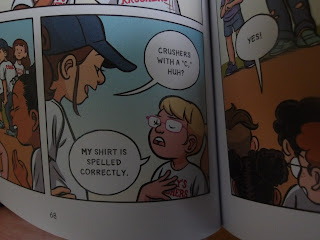Publication date: 2025
Illustrators: D. K. Yingst, with color by Braden Lamb
Synopsis:
Halloween is coming, and Karen could hardly be more excited. Her class is going to mark the occasion by telling scary stories. Despite it not being a competition, Karen is determined to have the scariest one. With Kristy's help, she researches her great-grandfather, Ben Brewer, whose ghost is said to haunt the attic of her father's house. According to a diary (written by Ben's son) that they find, Ben's ghost holds a birthday party every ten years on his birthday--this Halloween is the next one!
When the night finally arrives, Karen lays awake (sneaking a bit of candy), and sure enough, she hears noises and even smells cake baking. And the diary is in her room when she wakes up. In the morning, she reports this to her family, only to find mundane explanations for everything--her stepmother baked a cake in the middle of the night to celebrate Emily Michelle being able to count to ten (...'kay), older kids were setting off fireworks, etc.
However, the diary itself is left unexplained, as is the fact that Karen notices a few pages stuck together that she and Kristy hadn't seen before. Peeling them apart, Karen learns that as a child, Ben had a fight with a close friend and uninvited him from his tenth birthday party. Before they could make, the friend died. According to the diary, that friend's ghost haunted Ben for the rest of this life, and in death, Ben has a party every ten years to appease his friend's ghost.
Continuity related to BSC books:
Stoneybrook having been originally spelled with an E ("Stoneybrooke") comes up from time to time in the BSC books.Misc:
Martin dedicates the book to Paula.
Grant dedicates the book to "my mom, who handmade all my Halloween costumes, and my dad, who firmly believes full-size candy bars are the best treats. And thank you to Rachael and Karmyn; I enjoyed going trick-or-treating with you as I wrote this book."
Emily Michelle is in this book more than she has been in most others (including most of the Baby-sitter Club books).
My brother's birthday is on Halloween, like Ben Brewer. Mine is shortly after--my mom dressed as a jack-o-lantern the year I was born.

























